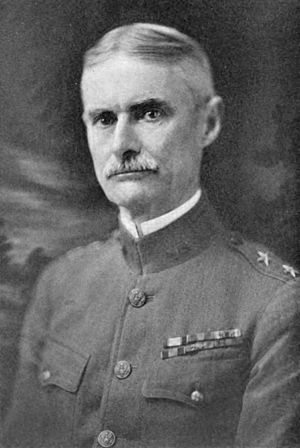William H. Hay facts for kids
Quick facts for kids
William H. Hay
|
|
|---|---|

William H. Hay as commander of the 28th Division in World War I.
|
|
| Nickname(s) | "Dad" |
| Born | July 16, 1860 Drifton, Florida |
| Died | December 17, 1946 (aged 86) New York City, New York |
| Place of burial |
West Point Cemetery
|
| Allegiance | United States of America |
| Service/ |
United States Army |
| Years of service | 1886–1922 |
| Rank | Major general |
| Commands held | 3rd Squadron, 3rd Cavalry 15th Cavalry Regiment 184th Infantry Brigade, 92nd Division 28th Division Intermediate Service Section, Army Services of Supply Camp Custer, Michigan 1st Cavalry Brigade |
| Battles/wars | Spanish–American War World War I |
| Awards | Army Distinguished Service Medal Croix de Guerre Legion of Honor (Commander) Order of the Black Star (Commander) Order of Leopold (Commander). |
| Spouse(s) | Edith Carman (1864–1958) |
| Children | Thomas Robson (1888–1974) William Wren (1890–1978) Edward Northrup (1891–1958) Richard Carman (1893–1930). |
| Other work | Construction supervisor, Camp Smith, New York |
William H. Hay (born July 16, 1860 – died December 17, 1946) was an important officer in the United States Army. He became a major general, which is a very high rank. During World War I, he led the 28th Infantry Division.
Contents
Growing Up and Early Training
William Henry Hay was born in Drifton, Florida on July 16, 1860. His father, Turner Hay, was also a soldier who fought in the Seminole Wars and the American Civil War.
In 1886, William Hay graduated from the United States Military Academy, also known as West Point. He was 22 years old, which was older than most of his classmates. Because of his age, his friends at West Point called him "Dad," a nickname that stayed with him throughout his life.
Starting His Military Journey
After West Point, Hay became a second lieutenant in the 3rd Cavalry Regiment. He served in places like Texas at Fort Davis and San Antonio.
He then went to a special school for soldiers at Fort Leavenworth. After that, he served with the 10th Cavalry Regiment in Montana.
Service in the Spanish–American War
During the Spanish–American War, Hay became a temporary captain. He worked in the quartermaster service, which handles supplies and logistics for the army.
He spent four years in Cuba, where he was in charge of customs in a city called Matanzas. He was very good at speaking and writing Spanish. This skill helped him organize the docks, warehouses, and offices under his care.
After the Spanish–American War
After the war, Hay returned to his regular rank of First Lieutenant. From 1902 to 1905, he served with the 10th Cavalry again.
From 1905 to 1909, he taught military science at Pennsylvania State University. He was also an excellent marksman and was part of the U.S. Cavalry National Rifle Team for several years. He even led the team as captain.
In 1913, Hay finished his studies at the Army War College and then became a teacher there. Before World War I, he served with the 4th Cavalry and later commanded the 15th Cavalry in the Philippines. In July 1916, he was promoted to colonel.
Leading in World War I
When World War I began, Hay was promoted to temporary Brigadier General. He led the 184th Infantry Brigade, which was part of the 92nd Division. This division was made up of African-American soldiers and white officers.
He led his brigade in battles in France, including the Meuse-Argonne Offensive. General Hay praised the African-American soldiers he commanded, saying he had "never seen better soldiers."
On October 26, 1918, Hay was promoted to temporary Major General. He was then given command of the 28th Division. He led this division until the war ended in November 1918. He remained in command until April 1919.
Life After World War I
From June 1919 to July 1920, Hay was the commander of Camp Custer, Michigan. In July 1920, he returned to his permanent rank of Colonel. He then worked as an Inspector General for the American forces in Germany.
In May 1921, he became the chief of staff for the American forces in Germany. In 1922, he was promoted to permanent Brigadier General and took command of the 1st Cavalry Brigade in Douglas, Arizona.
In 1922, Hay and his wife were in a car accident, which caused him to retire from the military in 1924. After recovering from his injuries, he worked as the superintendent of Camp Smith from 1926 to 1939. This was a training site for the New York National Guard.
In 1930, his two-star rank of major general was restored by a new law. This law allowed officers from World War I to retire at the highest rank they had held.
Later Years and Burial
Hay retired in 1939 and lived in New York City. He passed away in Glen Cove, New York on December 17, 1946. He was buried at the United States Military Academy Cemetery.
Awards and Honors
William H. Hay received several important awards for his service:
- Army Distinguished Service Medal (United States)
- French Croix de Guerre (France)
- Legion of Honor (Commander) (France)
- Order of the Black Star (Commander) (France)
- Order of Leopold (Commander) (Belgium)
Family Life
In 1887, William Hay married Edith Carman. They had four sons:
- Thomas Robson (1888–1974)
- William Wren (1890–1980)
- Edward Northup (1891–1958)
- Richard Carman (1893–1930)
See also
 In Spanish: William H. Hay para niños
In Spanish: William H. Hay para niños

